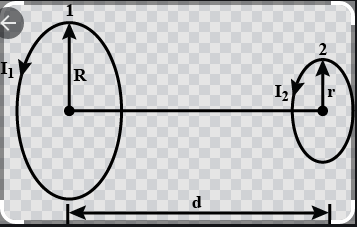A circular loop of radius 0.3 cm lies parallel to amuch bigger circular loop of radius 20 cm. The centre of the small loop is on the axis of the bigger loop. Obtain the mutual inductance of the two loops.
 Solution in Punjabi
Solution in Punjabi
Step by step video & image solution for A circular loop of radius 0.3 cm lies parallel to amuch bigger circular loop of radius 20 cm. The centre of the small loop is on the axis of the bigger loop. Obtain the mutual inductance of the two loops. by Physics experts to help you in doubts & scoring excellent marks in Class 12 exams.
Updated on:21/07/2023Topper's Solved these Questions
- ELECTROMAGNETIC INDUCTIONBOOK - MODERN PUBLICATIONCHAPTER - ELECTROMAGNETIC INDUCTIONEXERCISE - EXERCISE
146 Videos
- ELECTRICAL MEASUREMENTSBOOK - MODERN PUBLICATIONCHAPTER - ELECTRICAL MEASUREMENTSEXERCISE - EXERCISE
44 Videos
- ELECTROMAGNETIC WAVESBOOK - MODERN PUBLICATIONCHAPTER - ELECTROMAGNETIC WAVESEXERCISE - EXERCISE
66 Videos
Similar Questions
Explain the concept of magnetic flux linked with a surface.
View SolutionState and explain Kirchhoff's laws.
View SolutionWhy did Maxwell introduce the concept of displacement current ?Explain.
View SolutionA circular loop of radius 0.3 cm lies parallel to amuch bigger circular loop of radius 20 cm. The centre of the small loop is on the axis of the bigger loop. The distance between their centres is 15 cm. If a current of 2.0 A flows through the smaller loop, then the flux linked with bigger loop is
View SolutionFind mutual inductance if we have a square loop of side r instead of a small circular loop of side r at the centre of bigger circular loop.
View SolutionFind mutual inductance if we have a square loop of side r instead of a small circular loop of side r at the centre of bigger circular loop.
View Solutionत्रिज्या 0.3 सेमी का एक वृत्तीय लूप एक काफी बड़े त्रिज्या 20 सेमी त्रिज्या के वृत्तीय लूप के समांतर रखा है। छोटे लूप का केंद्र बड़े लूप के अक्ष पर है। उनके केंद्रों के बीच की दूरी 15 सेमी है। यदि बड़े लूप से 2.0 ऐम्पियर की धारा प्रवाहित होती है, तब लूप से संबंधित फ्लक्स है
View Solutionत्रिज्या 0.3 सेमी का एक वृत्तीय लूप एक काफी बड़े त्रिज्या 20 सेमी त्रिज्या के वृत्तीय लूप के समांतर रखा है। छोटे लूप का केंद्र बड़े लूप के अक्ष पर है। उनके केंद्रों के बीच की दूरी 15 सेमी है। यदि बड़े लूप से 2.0 ऐम्पियर की धारा प्रवाहित होती है, तब लूप से संबंधित फ्लक्स है
View SolutionFind mutual inductance if we have a square loop of side r instead of a small circular loop of side r at the centre of bigger circular loop.
View SolutionA circular loop of radius 0.3 cm lies parallel to amuch bigger circular loop of radius 20 cm. The centre of the small loop is on the axis of the bigger loop. The distance between their centres is 15 cm. If a current of 2.0 A flows through the smaller loop, then the flux linked with bigger loop is
View SolutionA circular loop of radius 0.3cm lies parallel to a much bigger circular loop of radius 20cm. The centre of the small loop is on the axis of the bigger loop. The distance between their centres is 15cm. (a) What is the flux linking the bigger loop if a current of 2.0 A flows through the smaller loop ? (b) Obtain the mutual inductance of the two loops.
View Solutionत्रिज्या 0.3 cm का एक वृत्तीय लूप एक काफी बड़े त्रिज्या 20 cm के वृतीय लूप के समान्तर रखा है। छोटे लूप का केन्द्र बड़े लूप की अक्ष पर है। उनके केन्द्रों के बीच दूरी 15 cm है। यदि छोटे लूप से 2.0 A की धारा प्रवाहित होती है, तब बड़े लूप से सम्बद्धित फ्लक्स है:
View SolutionA circular loop of radius 0.3 cm lies parallel to amuch bigger circular loop of radius 20 cm. The centre of the small loop is on the axis of the bigger loop. The distance between their centres is 15 cm. If a current of 2.0 A flows through the smaller loop, then the flux linked with bigger loop is
View SolutionA circular loop of radius 0.3cm lies parallel to a much biger circular loop of radius 20cm the centre of small loop is on the axis of the bigger loop the distance between their centres is 15 cm if a current of 2.0A flows through the smaller loop then the flux linked with bigger loop is
View SolutionFind mutual inductance if we have a square loop of side r instead of a small circular loop of side r at the centre of bigger circular loop.
View Solution
